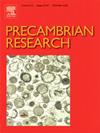青藏高原东北部全济地块新元古代a型花岗岩成因及构造意义
IF 3.2
2区 地球科学
Q2 GEOSCIENCES, MULTIDISCIPLINARY
引用次数: 0
摘要
a型花岗岩具有独特的地球化学特征,指示了伸展构造环境,为岩浆来源和构造机制提供了关键约束,在重建造山事件中起着至关重要的作用。本文对青藏高原东北部全济地块新发现的a型花岗岩进行了锆石U-Pb年代学、全岩地球化学和锆石Hf同位素的系统研究,探讨了其岩石成因及其构造意义。锆石U-Pb定年结果表明,花岗岩和花岗斑岩的结晶年龄分别为797±8 Ma和799±7 Ma,形成于新元古代。岩石地球化学特征为SiO2 (67.47 ~ 75.74 wt%)、总碱(Na2O + K2O = 6.89 ~ 8.84 wt%)含量高,MgO (0.11 ~ 1.37 wt%)、CaO (0.76 ~ 1.29 wt%)、P2O5 (0.05 ~ 0.18 wt%)含量低,Nb、Ta、Ti、Sr、Eu等元素呈负异常。它们具有较高的FeOT /(MgO + FeOT)值,Zr + Nb + Ce + Y含量(343 ~ 562 ppm), 10000 × Ga/Al比值(2.12 ~ 3.20),锆石饱和温度(804 ~ 860℃),符合典型a型花岗岩的特征。高的K2O/Na2O比值、低的Sr/Y和La/Yb比值,结合锆石εHf(t)值(-4.04 ~ 3.25)和全岩εNd(t)值(-8.28 ~ -4.91),表明a型花岗岩是在高温低压条件下由古地壳钙碱性岩石部分熔融而成,并有中等程度的幼壳贡献。根据构造背景判别图结合区域资料,综合确定a型花岗岩形成于碰撞后伸展环境,是对Rodinia超大陆分裂的响应。根据全济地块及邻近地区的综合资料表明,全济地块、柴达木地块和祁连地块在晚中元古代—新元古代合并成一个统一地块,参与了罗迪尼亚超大陆的演化。本文章由计算机程序翻译,如有差异,请以英文原文为准。
Petrogenesis and tectonic implications of the Neoproterozoic A-type granite in the Quanji Massif, northeastern of the Tibetan Plateau
A-type granites have unique geochemical characteristics, indicating an extensional tectonic environment, thus providing critical constraints on magma sources and tectonic mechanisms, and playing a crucial role in reconstructing orogenic events. In this contribution, we conducted a systematic study on zircon U-Pb geochronology, whole-rock geochemistry, and zircon Hf isotope of the new identified A-type granites in the Quanji Massif in the northeastern Tibetan Plateau to discuss its petrogenesis and the tectonic implications. The zircon U-Pb dating results show that the crystallization ages of granites and granite porphyries are 797 ± 8 Ma and 799 ± 7 Ma, respectively, indicating that they were formed in the Neoproterozoic. Geochemically, these rocks have high SiO2 (67.47–75.74 wt%) and total alkali (Na2O + K2O = 6.89–8.84 wt%) contents, low MgO (0.11–1.37 wt%), CaO (0.76–1.29 wt%), and P2O5 (0.05–0.18 wt%) contents, with negative anomalies of Nb, Ta, Ti, Sr, and Eu elements. They have high FeOT /(MgO + FeOT) values, Zr + Nb + Ce + Y contents (343–562 ppm), 10000 × Ga/Al ratio (2.12–3.20), and zircon saturation temperature (804–860 ℃), which are consistent with the characteristics of typical A-type granites. Their high K2O/Na2O ratios, low Sr/Y and La/Yb ratios, combined with the zircon εHf(t) values (–4.04 to 3.25) and the whole-rock εNd(t) values (–8.28 to –4.91), indicate that the A-type granites were derived from partial melting of the calc-alkaline rocks in the ancient crust with a moderate contribution of juvenile crust under high temperature and low-pressure conditions. Based on the tectonic setting discrimination diagram combined with regional data, it is comprehensively determined that the A-type granites were formed in the post-collisional extensional environment, which is a response to the breakup of the Rodinia supercontinent. According to the comprehensive data of the Quanji Massif and adjacent areas show that the Quanji Massif, the Qaidam Block and the Qilian Block were combined into a unified block during the Late Mesoproterozoic-Neoproterozoic and participated in the evolution of the Rodinia supercontinent.
求助全文
通过发布文献求助,成功后即可免费获取论文全文。
去求助
来源期刊

Precambrian Research
地学-地球科学综合
CiteScore
7.20
自引率
28.90%
发文量
325
审稿时长
12 months
期刊介绍:
Precambrian Research publishes studies on all aspects of the early stages of the composition, structure and evolution of the Earth and its planetary neighbours. With a focus on process-oriented and comparative studies, it covers, but is not restricted to, subjects such as:
(1) Chemical, biological, biochemical and cosmochemical evolution; the origin of life; the evolution of the oceans and atmosphere; the early fossil record; palaeobiology;
(2) Geochronology and isotope and elemental geochemistry;
(3) Precambrian mineral deposits;
(4) Geophysical aspects of the early Earth and Precambrian terrains;
(5) Nature, formation and evolution of the Precambrian lithosphere and mantle including magmatic, depositional, metamorphic and tectonic processes.
In addition, the editors particularly welcome integrated process-oriented studies that involve a combination of the above fields and comparative studies that demonstrate the effect of Precambrian evolution on Phanerozoic earth system processes.
Regional and localised studies of Precambrian phenomena are considered appropriate only when the detail and quality allow illustration of a wider process, or when significant gaps in basic knowledge of a particular area can be filled.
 求助内容:
求助内容: 应助结果提醒方式:
应助结果提醒方式:


